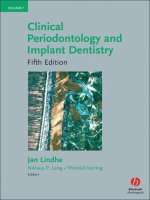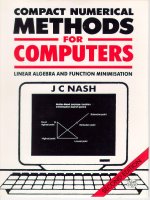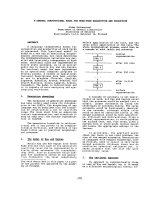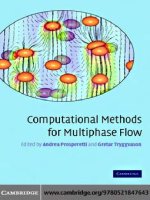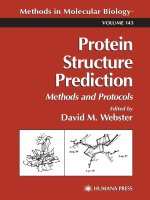Computational Methods for Protein Structure Prediction and Modeling Volume 1: Basic Characterization pot
Bạn đang xem bản rút gọn của tài liệu. Xem và tải ngay bản đầy đủ của tài liệu tại đây (9.64 MB, 407 trang )
SVNY330-Xu-Vol-I November 4, 2006 10:1
BIOLOGICAL AND MEDICAL PHYSICS,
BIOMEDICAL ENGINEERING
i
SVNY330-Xu-Vol-I November 4, 2006 10:1
BIOLOGICAL AND MEDICAL PHYSICS
BIOMEDICAL ENGINEERING
Editor-in-Chief:
Elias Greenbaum, Oak Ridge National Laboratory, Oak Ridge, Tennessee, USA
Volumes Published in This Series:
The Physics of Cerebrovascular Diseases, Hademenos, G.J., and Massoud, T.F., 1997
Lipid Bilayers: Structure and Interactions, Katsaras, J., 1999
Physics with Illustrative Examples from Medicine and Biology: Mechanics, Second Edition,
Benedek, G.B., and Villars, F.M.H., 2000
Physics with Illustrative Examples from Medicine and Biology: Statistical Physics, Second
Edition, Benedek, G.B., and Villars, F.M.H., 2000
Physics with Illustrative Examples from Medicine and Biology: Electricity and Magnetism,
Second Edition, Benedek, G.B., and Villars, F.M.H., 2000
Physics of Pulsatile Flow, Zamir, M., 2000
Molecular Engineering of Nanosystems, Rietman, E.A., 2001
Biological Systems Under Extreme Conditions: Structure and Function, Taniguchi, Y. et al., 2001
Intermediate Physics for Medicine and Biology, Third Edition, Hobbie, R.K., 2001
Epilepsy as a Dynamic Disease, Milton, J., and Jung, P. (Eds), 2002
Photonics of Biopolymers, Vekshin, N.L., 2002
Photocatalysis: Science and Technology, Kaneko, M., and Okura, I., 2002
E. coli in Motion, Berg, H.C., 2004
Biochips: Technology and Applications, Xing, W L., and Cheng, J. (Eds.), 2003
Laser-Tissue Interactions: Fundamentals and Applications, Niemz, M., 2003
Medical Applications of Nuclear Physics, Bethge, K., 2004
Biological Imaging and Sensing, Furukawa, T. (Ed.), 2004
Biomaterials and Tissue Engineering, Shi, D., 2004
Biomedical Devices and Their Applications, Shi, D., 2004
Microarray Technology and Its Applications, Muller, U.R., and Nicolau, D.V. (Eds), 2004
Emergent Computation: Emphasizing Bioinformatics, Simon, M., 2005
Molecular and Cellular Signaling, Beckerman, M., March 22, 2005
The Physics of Coronary Blood Flow, Zamir, M., May, 2005
The Physics of Birdsong Mindlin, G.B., Laje, R., August, 2005
Radiation Physics for Medical Physicists Podgorsak, E.B., September 2005
Neutron Scattering in Biology—Techniques and Applications Fitter, J., Gutberlet, T., Katsaras, J.
(Eds.), January 2006
Forthcoming Titles
Topology in Molecular Biology: DNA and Proteins Monastyrsky, M.I. (Ed.), 2006
Optical Polarization in Biomedical Applications Tuchin, V.V., Wang, L. (et al.), 2006
Continued After Index
ii
SVNY330-Xu-Vol-I November 4, 2006 10:1
Ying Xu, Dong Xu, and
Jie Liang (Eds.)
Computational Methods
for Protein Structure
Prediction and Modeling
Volume 1: Basic Characterization
iii
SVNY330-Xu-Vol-I November 4, 2006 10:1
Ying Xu
Department of Biochemistry
and Molecular Biology
University of Georgia
120 Green Street
Athens, GA 30602
USA
email:
Dong Xu
Department of Computer Science
Digital Biology Laboratory
University of Missouri–Columbia
201 Engineering Building West
Columbia, MO 65211
USA
email:
Jie Liang
Department of Bioengineering
Center for Bioinformatics
University of Illinois at Chicago
851 S. Morgan Street
Chicago, IL 60607
USA
email:
Library of Congress Control Number: 2006929615
ISBN 10: 0-387-33319-3
ISBN 13: 978-0387-33319-9
Printed on acid-free paper.
C
2007 Springer Science+Business Media, LLC
All rights reserved. This work may not be translated or copied in whole or in part without the written permission
of the publisher(Springer Science+Business Media,LLC, 233 Spring Street,New York, NY 10013, USA), exceptfor
brief excerpts in connection with reviews or scholarly analysis. Use in connection with any form of information
storage and retrieval, electronic adaptation, computer software, or by similar or dissimilar methodology now
known or hereafter developed is forbidden.
The use in this publication of trade names, trademarks, service marks, and similar terms, even if they are
not identified as such, is not to be taken as an expression of opinion as to whether or not they are subject to
proprietary rights.
987654321
springer.com
iv
SVNY330-Xu-Vol-I November 4, 2006 10:1
Preface
An ultimate goal of modern biology is to understand how the genetic blueprint of
cells (genotype) determines the structure, function, and behavior of a living organism
(phenotype). At the center of this scientific endeavor is characterizing the biochem-
ical and cellular roles of proteins, the working molecules of the machinery of life. A
key to understanding of functional proteins is the knowledge of their folded struc-
tures in a cell, as the structures provide the basis for studying proteins’ functions
and functional mechanisms at the molecular level.
Researchers working on structure determination have traditionally selected in-
dividual proteins due to their functional importance in a biological process or path-
way of particular interest. Major research organizations often have their own protein
X-ray crystallographic or/and nuclear magnetic resonance facilities for structure de-
termination, which have been conducted at a rate of a few to dozens of structures a
year. Realizing the widening gap between the rates of protein identification (through
DNA sequencing and identification of potential genes through bioinformatics anal-
ysis) and the determination of protein structures, a number of large scientific initia-
tives have been launched in the past few years by government funding agencies in
the United States, Europe, and Japan, with the intention to solve protein structures
en masse, an effort called structural genomics. A number of structural genomics
centers (factory-like facilities) have been established that promise to produce solved
protein structures in a similar fashion to DNA sequencing. These efforts as well as
the growth in the size of the community and the substantive increases in the ease
of structure determination, powered with a new generation of technologies such as
synchrotron radiation sources and high-resolution NMR, have accelerated the rate
of protein structure determination over the past decade. As of January 2006, the
protein structure database PDB contained ∼34,500 protein structures.
The role of structure for biological sciences and research has grown consider-
ably since the advent of systems biology and the increased emphasis on understand-
ing molecular mechanisms from basic biology to clinical medicine. Just as every
geneticist or cell biologist needed in the 1990s to obtain the sequence of the gene
whose product or function they were studying, increasingly, those biologists will
need to know the structure of the gene product for their research programs in this
century. One can anticipate that the rate of structure determination will continue to
grow. However, the large expenses and technical details of structure determination
mean that it will remain difficult to obtain experimental structures for more than a
small fraction of the proteins of interest to biologists. In contrast, DNA sequence
determination has doubled routinely in output for a couple of decades. The genome
projects have led to the production of 100 gigabytes of DNA data in Genbank, and
v
SVNY330-Xu-Vol-I November 4, 2006 10:1
vi Preface
as the cost of sequencing continues to drop and the rate continues to accelerate, the
scientific community anticipates a day when every individual has the genes of their
interest and the genomes of all related major organisms sequenced.
Structure determination of proteins began before nucleic acids could be se-
quenced,which now appearsalmost ironic. As microchemistry technologies continue
to mature, ever more powerful DNA sequencing instruments and new methods for
preparation of suitable quantities of DNA and cheaper, higher sequencing through-
put, while enabling a revolution in the biological and biomedical sciences, also left
structure determination way behind. As sequencing capacity matured in the last few
decades of the twentieth century, DNA sequences exceeded protein structures by
10-fold, then 100-fold, and now there is a 1000-fold difference between the number
of genes in Genbank and the number of structures in the PDB. The order of magni-
tude difference is about to jump again, in the era of metagenomics, as the analyses of
communities of largely unculturable organisms in their natural states come to dom-
inate sequence production. The J. Craig Venter Institute’s Sargasso Sea experiment
and other early metagenomics experiments at least doubled the number of known
open reading frames (ORFs) and potential genes, but the more recent ocean voyage
data (or GOS) multipled the number on the order of another 10-fold, probably more.
The rate of discovery of novel genes and correspondingly novel proteins has not
leveled off, since nearly half of new microbial genomes turn out to be novel. Fur-
thermore, in the metagenomics data, new families of proteins are discovered directly
proportional to the rate of gene (ORF) discovery.
The bottom line is quite simple. Despite the several fold reduction in cost in
structure determination due to the structural genomics projects—the NIH Protein
Structure Initiative and comparable initiatives around the world—and the steady
increase in the rate of protein structure determination, the number of proteins with
unknown structures will continue to grow vastly faster. At an early structural ge-
nomics meeting in Avalon, New Jersey, the experimental community voted in favor
of experimentally solving 100,000 structures of proteins with less than30% sequence
identity to proteins with known structures. This seemed to some theoreticians at the
time as solving “the protein structure problem” and removing the need for theory,
simulation, and prediction. Now, while it appears that this goal is aiming too high
for just the initiative alone, certainly, the structural community will have 100,000
structures in the PDB not long after the end of this decade—and probably sooner
than expected as costs continue to go down and technologies continue to advance.
Yet, those 100,000 structures will be significantly less than 1% of the known ORFs
genes! The problem, therefore, is not about having structures to predict, but having
robust enough methods to make predictions that are useful at deep levels in biology,
from helping us infer function and directing experimental efforts to providing insight
into ligand binding, molecular recognition, drug discovery, and so on. The kind of
success in terms of “reasonable” accuracy for “most” targets has been the grand suc-
cess of the CASP competition (see Chapter 1) but is completely inadequate for the
biology of the twenty-first century and the expectations of both basic and applied life
sciences. Prediction is not at the requisite level of comprehensive robustness yet, and
therein is one of the features of critical importance of the discussions in this book.
SVNY330-Xu-Vol-I November 4, 2006 10:1
Preface vii
Computational methods for predicting protein structure have been actively
pursued for some time. Their acceptance and importance grew rapidly after the es-
tablishment of a blind competition for predicting protein structure, namely, CASP.
CASP involves theoreticians predicting then-unknown protein structures and their
verification and analysis following subsequent experimental determination. The val-
idation of the general approach both enhanced funding and brought participants to
the field and pointed to the limitations of current methods and the value of extensive
research into advanced computational tools. Overall, the rapidly growing importance
of structural data for biology fueled the emergence of a new branch of computational
biology and of structural biology, an interface between the methods of bioinformat-
ics and molecular biophysics, namely, structural bioinformatics. Similar to genomic
sequence analysis, bioinformatic studies of protein structures could lead to both
deep and general or broad insights about aspects such as the folding, evolution, and
function of proteins, the nature of protein–ligand and protein–protein interactions,
and the mechanisms by which proteins act. The success of such studies could have
immense impacts not just on science but on the whole society through providing in-
sight into the molecular etiology of diseases, developing novel, effective therapeutic
agents and treatment regimens, and engineering biological molecules for novel or
enhanced biochemical functions.
As one of the most active research fields in bioinformatics, structural bioinfor-
matics addresses a wide spectrum of scientific issues, including the computational
prediction of protein secondary and tertiary structures, protein docking with small
molecules and with macromolecules (i.e., DNA, RNA, and proteins), simulation of
dynamic behaviors of proteins, protein structure characterization and classification,
and study of structure–function relationships. While proteins were viewed as es-
sentially static three-dimensional structures up until the 1980s, the establishment of
computational methods, and subsequent advances in experimental probes that could
provide data at suitable time scales, led to a revolution in how biologists think about
proteins. Indeed, over the past few decades, computational studies using molecular
dynamics simulations of protein structure have played essential roles in understand-
ing the detailed functional mechanisms of proteins important in a wide variety of
biological processes. Within the applied life sciences, protein docking has been ex-
tensively applied in the drug discovery pipeline in the pharmaceutical and biotech
industry.
Protein structure prediction and modeling tools are becoming an integral part of
the standard toolkit in biological and biomedical research. Similar to sequence anal-
ysis tools, such as BLAST for sequence comparison, the new methods for structure
prediction are now among the first approaches used when starting a biological inves-
tigation, conducted prior to actual experimental design. That computational analysis
would become the first step for experimentalists represents a major paradigm shift
that is still occurring but is clearly essential to deal with the maturation of the field,
the large quantities of data, and the complexity of biology itself as reflected in the
requirement for today’s powerful experimental probes used to address sophisticated
questions in biology. This paradigm shift was noted first by Wally Gilbert, in a pre-
scient article fifteen years ago (“Toward a new paradigm for molecular biology,”
SVNY330-Xu-Vol-I November 4, 2006 10:1
viii Preface
Nature 1991, 349:99), who asserted that biologists would have to change their mode
of approach to studying nature and to begin each experimental project with a bioin-
formatics analysis of extant literature and other computational approaches. This
paradigm shift is deeply interconnected with the increased emphasis on computa-
tional tools and the expectation for robust methods for structure prediction.
Similar to other fields of bioinformatics, structural bioinformatics is a rapidly
growing science. New computational techniques and new research foci emerge every
few months, which makes the writing of textbooks a challenging problem. While a
number of books have been published covering various aspects of protein structure
prediction and modeling, it is widely recognized that the field lacks a comprehensive
and coherent overview of the science of “protein structure prediction and modeling,”
which span a range from very basic problems (around physical and chemical prop-
erties and principles), such as the potential function and free energies that determine
the folded shape of a protein, to the algorithmic techniques for solving various struc-
ture prediction problems, to the engineering aspects of implementation of computer
prediction software, and to applications of prediction capabilities for investigations
focused on functional properties. As educators at universities, we feel that there is
an urgent need for a well-written, comprehensive textbook, one that proverbially
goes from soup to nuts, and that this requirement is most critical for beginners en-
tering this field as young students or as experienced researchers coming from other
disciplines.
This book is an attempt to fill this gap by providing systematic expositions of the
computational methods for all major aspects of protein structure analysis, prediction,
and modeling. We have designed the chapters to address comprehensively the main
topics of the field. In addition, chapters have been connected seamlessly through a
systematic design of the overall structure of the book. We have selected individual
topics carefully so that the book would be useful to a broad readership, including
students, postdoctoral fellows, research scientists moving into the field, as well as
professional practitioners/bioinformatics experts who want to brush up on topics
related to their own research areas. We expect that the book can be used as a textbook
for upper undergraduate-level or graduate-level bioinformatics courses. Extensive
prior knowledge is not required to read and comprehend the information presented.
In other words, a dedicated reader with a college degree in computational, biological,
or physical science should be able to follow the book without much difficulty. To
facilitate learning and to articulate clearly to the reader what background is needed
to obtain the maximum benefit from the book, we have included four appendices
describing the prerequisites in (1) biology, (2) computer science, (3) physics and
chemistry, and (4) mathematics and statistics. If a reader lacks knowledge in a
particular area, he or she could benefit by starting from the references provided in
the corresponding appendix.
While the chapters are organized in a logical order, each chapter in the book is
a self-contained review of a specific subject. Hence, a reader does not need to read
through the chapters sequentially. Each chapter is designed to cover the following
material: (1) the problem definition and a historical perspective, (2) a mathematical
or computational formulation of the problem, (3) the computational methods and
SVNY330-Xu-Vol-I November 4, 2006 10:1
Preface ix
algorithms, (4) the performance results, (5) the existing software packages, (6) the
strengths, pitfalls, and challenges in current research, and (7) the most promising
future directions. Since this is a rapidly developing field that encompasses an ex-
ceptionally wide range of research topics, it is difficult for any individual to write a
comprehensive textbook on the entire field. We have been fortunate in assembling
a team of experts to write this book. The authors are actively doing research at the
forefront of the major areas of the field and bring extensive experience and insight
into the central intellectual methods and ideas in the subdomain and its difficulties,
accomplishments, and potential for the future.
Chapter 1 (A Historical Perspective and Overview of Protein Structure
Prediction) gives a perspective on the methods for the prediction of protein structure
and the progress that has been achieved. It also discusses recent advances and the
role of protein structure modeling and prediction today, as well as touching briefly
on important goals and directions for the future.
Chapter 2 (Empirical Force Fields) addresses the physical force fields used in
the atomic modeling of proteins, including bond, bond-angle, dihedral, electrostatic,
van der Waals, and solvation energy. Several widely used physical force fields are
introduced, including CHARMM, AMBER, and GROMOS.
Chapter 3 (Knowledge-Based Energy Functions for Computational Studies
of Proteins) discusses the theoretical framework and methods for developing
knowledge-based potential functions essential for protein structure prediction,
protein–protein interaction, and protein sequence design. Empirical scoring func-
tions including single-body energy function, statistical method for pairwise interac-
tion between amino acids, and scoring function based on optimization are addressed.
Chapter 4 (Computational Methods for Domain Partitioning of Protein
Structures) covers the basic concept of protein structural domains and practical
applications. A number of computational techniques for domain partition are de-
scribed, along with their applications to protein structure prediction. Also described
are a few, widely used, protein domain databases and associated analysis tools.
Chapter 5 (Protein Structure Comparison and Classification) discusses the ba-
sic problem of protein structure comparison and applications, and computational ap-
proaches for aligning two protein structures. Applications of the structure–structure
alignment algorithms to protein structure search against the PDB and to protein
structural motif search in the PDB are also discussed.
Chapter 6 (Computation of Protein Geometry and Its Applications: Packing
and Function Prediction) treats protein structures as 3D geometrical objects, and
discusses structural issues from a geometric point of view, such as (1) the union
of ball models, molecular surface, and solvent-accessible surface, (2) geometric
constructs such as Voronoi diagram, Delaunay triangulation, alpha shape, surface
geometry (including cavities and pockets) and their computation, (3) local surface
similarity measure in terms of shape and sequence, and (4) function prediction
based on protein surface patterns. Also described are the application issues of these
computational techniques.
Chapter 7 (Local Structure Prediction of Proteins) covers protein secondary
structure prediction, supersecondary structure prediction, prediction of disordered
SVNY330-Xu-Vol-I November 4, 2006 10:1
x Preface
regions, and applications to tertiary structure prediction. A number of popular pre-
diction software packages are described.
Chapter 8 (Protein Contact Maps Prediction) describes the basic principles for
residue contact predictions, and computational approaches for prediction of residue–
residue contacts. Also discussed is the relevance to tertiary structure prediction. A
number of popular prediction programs are introduced.
Chapter 9 (Modeling Protein Aggregate Assembly and Structure) describes the
basic problem of structure misfolding and implications, experimental approach for
data collection in support of computational modeling, computational approaches to
prediction of misfolded structures, and related applications.
Chapter 10 (Homology-Based Modeling of Protein Structure) presents the
foundation for homology modeling, computational methods for sequence–sequence
alignment and constructing atomic models, structural model assessment, and manual
tuning of homology models. A number of popular modeling packages are introduced.
Chapter 11 (Modeling Protein Structures Based on Density Maps at Interme-
diate Resolutions) discusses methods for constructing atomic models from density
maps of proteins at intermediate resolution, such as those obtained from electron cry-
omicrosopy. Details of application of computational tools for identifying ␣-helices,
ß-sheets, as well as geometric analysis are described.
Chapter 12 (Protein Structure Prediction by Protein Threading) describes the
threading approach for predicting protein structure. It discusses the basic concepts of
protein folds, an empirical energy function, and optimal methods for fitting a protein
sequence to a structural template, including the divide-and-conquer, the integer
programming, and tree-decomposition approaches. This chapter also gives practical
guidance, along with a list of resources, on using threading for structure prediction.
Chapter 13 (De Novo Protein Structure Prediction) describes protein folding
and free energy minimization, lattice model and search algorithms, off-lattice model
and search algorithms, and mini-threading. Benchmark performance of various tools
in CASP is described.
Chapter 14 (Structure Prediction of Membrane Proteins) covers the methods
for prediction of secondary structure and topology of membrane proteins, as well as
prediction of their tertiary structure. A list of useful resources for membrane protein
structure prediction is also provided.
Chapter 15 (Structure Prediction of Protein Complexes) describes computa-
tional issues for docking, including protein–protein docking (both rigid body and
flexible docking), protein–DNA docking, and protein–ligand docking. It covers com-
putational representation for biomolecular surface, various docking algorithms, clus-
tering docking results, scoring function for ranking docking results, and start-of-the-
art benchmarks.
Chapter 16 (Structure-Based Drug Design) describes computational issues for
rational drug design based on protein structures, including protein therapeutics
based on cytokines, antibodies, and engineered enzymes, docking in structure-
based drug design as a virtual screening tool in lead discovery and optimization,
and ligand-based drug design using pharmacophore modeling and quantitative
SVNY330-Xu-Vol-I November 4, 2006 10:1
Preface xi
structure–activity relationship. A number of software packages for structure-based
design are compared.
Chapter 17(Protein Structure Prediction asa Systems Problem) providesa novel
systematic view on solving the complex problem of protein structure prediction.
It introduces consensus-based approach, pipeline approach, and expert system for
predicting protein structure and for inferring protein functions. This chapter also
discusses issues such as benchmark data and evaluation metrics. An example of
protein structure prediction at genome-wide scale is also given.
Chapter 18 (Resources and Infrastructure for Structural Bioinformatics) de-
scribes tools, databases, and other resources of protein structure analysis and pre-
diction available on the Internet. These include the PDB and related databases and
servers, structural visualization tools, protein sequence and function databases, as
well as resources for RNA structure modeling and prediction. It also gives informa-
tion on major journals, professional societies, and conferences of the field.
Appendix 1 (Biological and Chemical Basics Related to Protein Structures)
introduces central dogma of molecular biology, macromolecules in the cell (DNA,
RNA, protein), amino acid residues, peptide chain, primary, secondary, tertiary, and
quaternary structure of proteins, and protein evolution.
Appendix 2 (Computer Science for Structural Informatics) discusses computer
science concepts that are essential for effective computation for protein structure
prediction. These include efficient data structure, computational complexity and
NP-hardness, various algorithmic techniques, parallel computing,and programming.
Appendix 3 (Physical and Chemical Basis for Structural Bioinformatics) covers
basic concepts of our physical world, including unit system, coordinate systems,
and energy surfaces. It also describes biochemical and biophysical concepts such
as chemical reaction, peptide bonds, covalent bonds, hydrogen bonds, electrostatic
interactions, van der Waals interactions, as well as hydrophobic interactions. In
addition, this chapter discusses basic concepts from thermodynamics and statistical
mechanics. Computational sampling techniques such as molecular dynamics and
Monte Carlo method are also discussed.
Appendix 4 (Mathematics and Statistics for Studying Protein Structures) covers
various basic concepts in mathematics and statistics, often used in structural bioin-
formatics studies such as probability distributions (uniform, Gaussian, binomial and
multinomial, Dirichlet and gamma, extreme value distribution), basics of informa-
tion theory including entropy, relative entropy, and mutual information, Markovian
process and hidden Markov model, hypothesis testing, statistical inference (maxi-
mum likelihood, expectation maximization, and Bayesian approach), and statistical
sampling (rejection sampling, Gibbs sampling, and Metropolis–Hastings algorithm).
Ying Xu
Dong Xu
Jie Liang
John Wooley
April 2006
SVNY330-Xu-Vol-I November 4, 2006 10:1
Acknowledgments
During the editing of this book, we, the editors, have received tremendous help
from many friends, colleagues, and families, to whom we would like to take this
opportunity to express our deep gratitude and appreciation. First we would like to
thank Dr. Eli Greenbaum of Oak Ridge National Laboratory, who encouraged us
to start this book project and contacted the publisher at Springer on our behalf.
We are very grateful to the following colleagues who have critically reviewed the
drafts of the chapters of the book at various stages: Nick Alexandrov, Nir Ben-Tal,
Natasja Brooijmans, Chris Bystroff, Pablo Chacon, Luonan Chen, Zhong Chen,
Yong Duan, Roland Dunbrack, Daniel Fischer, Juntao Guo, Jaap Heringa, Xiche
Hu, Ana Kitazono, Ioan Kosztin, Sandeep Kumar, Xiang Li, Guohui Lin, Zhijie
Liu, Hui Lu, Alex Mackerell, Kunbin Qu, Robert C. Rizzo, Ilya Shindyalov, Ambuj
Singh, Alex Tropsha, Iosif Vaisman, Ilya Vakser, Stella Veretnik, Björn Wallner, Jin
Wang, Zhexin Xiang, Yang Dai, Xin Yuan, and Yaoqi Zhou. Their invaluable input
on the scientific content, on the pedagogical style, and on the writing style helped to
improve these book chapters significantly. We also want to thank Ms. Joan Yantko
of the University of Georgia for her tireless help on numerous fronts in this book
project, including taking care of a large number of email communications between
the editors and the authors and chasing busy authors to get their revisions and other
materials. Last but not least, we want to thank our families for their constant support
and encouragement during the process of us working on this book project.
xiii
SVNY330-Xu-Vol-I November 4, 2006 10:1
Contents
Contributors
xvii
1 A Historical Perspective and Overview of Protein
Structure Prediction 1
John C. Wooley and Yuzhen Ye
2 Empirical Force Fields 45
Alexander D. MacKerell, Jr.
3 Knowledge-Based Energy Functions for Computational
Studies of Proteins 71
Xiang Li and Jie Liang
4 Computational Methods for Domain Partitioning of
Protein Structures 125
Stella Veretnik and Ilya Shindyalov
5 Protein Structure Comparison and Classification 147
Orhan C¸ amo˘glu and Ambuj K. Singh
6 Computation of Protein Geometry and Its Applications:
Packing and Function Prediction 181
Jie Liang
7 Local Structure Prediction of Proteins 207
Victor A. Simossis and Jaap Heringa
8 Protein Contact Map Prediction 255
Xin Yuan and Christopher Bystroff
9 Modeling Protein Aggregate Assembly and Structure 279
Jun-tao Guo, Carol K. Hall, Ying Xu, and Ronald B. Wetzel
10 Homology-Based Modeling of Protein Structure 319
Zhexin Xiang
xv
SVNY330-Xu-Vol-I November 4, 2006 10:1
xvi Contents
11 Modeling Protein Structures Based on Density Maps
at Intermediate Resolutions 359
Jianpeng Ma
Index 389
SVNY330-Xu-Vol-I November 4, 2006 10:1
Contributors
Natasja Brooijmans
Chemical and Screening Sciences
Wyeth Research
Pearl River, New York 10965
Christopher Bystroff
Department of Biology
Rensselaer Polytechnic Institute
Troy, New York 12180
Liming Cai
Department of Computer Science
University of Georgia
Athens, Georgia 30602-7404
Orhan Camoglu
Department of Computer Science
University of California Santa Barbara
Santa Barbara, California 93106
Yang Dai
Department of Bioengineering
University of Illinois at Chicago
Chicago, Illinois 60607-7052
Haobo Guo
Department of Biochemistry and
Cellular and Molecular Biology
University of Tennessee
Knoxville, Tennessee 37996
Hong Guo
Department of Biochemistry and
Cellular and Molecular
Biology
University of Tennessee
Knoxville, Tennessee 37996
Jun-tao Guo
Department of Biochemistry and
Molecular Biology
University of Georgia
Athens, Georgia 30602-7229
Carol K. Hall
Department of Chemical and
Biomolecular Engineering
North Carolina State University
Raleigh, North Carolina 27695
Jaap Heringa
Centre for Integrative Bioinformatics
Vrije Universiteit
1081 HV Amsterdam, The
Netherlands
xvii
SVNY330-Xu-Vol-I November 4, 2006 10:1
xviii Contributors
Xiche Hu
Department of Chemistry
University of Toledo
Toledo, Ohio 43606
Ling-Hong Hung
Department of Microbiology
University of Washington
Seattle, Washington 98195-7242
Xiang Li
Department of Bioengineering
University of Illinois at Chicago
Chicago, Illinois 60607-7052
Jie Liang
Department of Bioengineering
University of Illinois at Chicago
Chicago, Illinois 60607-7052
Guohui Lin
Department of Computing Science
University of Alberta
Edmonton, Alberta T6G 2E8, Canada
Zhijie Liu
Department of Biochemistry and
Molecular Biology
University of Georgia
Athens, Georgia 30602-7229
Hui Lu
Department of Bioengineering
University of Illinois at Chicago
Chicago, Illinois 60607-7052
Jianpeng Ma
Department of Biochemistry and
Molecular Biology
Baylor College of Medicine
Houston, Texas 77030
and
Department of Bioengineering
Rice University
Houston, Texas 77005
Alexander D. MacKerell, Jr.
Department of Pharmaceutical
Chemistry
School of Pharmacy
University of Maryland
Baltimore, Maryland 21201
Shing-Chung Ngan
Department of Microbiology
University of Washington
Seattle, Washington 98195-7242
Ognjen Periˇsi´c
Department of Bioengineering
University of Illinois at Chicago
Chicago, Illinois 60607-7052
SVNY330-Xu-Vol-I November 4, 2006 10:1
Contributors xix
Brian Pierce
Department of Biomedical
Engineering
Boston University
Boston, Massachusetts 02215
Kunbin Qu
Department of Chemistry
Rigel Pharmaceuticals, Inc.
San Francisco, California 94080
Ram Samudrala
Department of Microbiology
University of Washington
Seattle, Washington 98195-7242
Ilya Shindyalov
San Diego Supercomputer Center
University of California San Diego
San Diego, California 92093-0505
Victor A. Simossis
Centre for Integrative Bioinformatics
Vrije Universiteit
1081 HV Amsterdam, The Netherlands
Ambuj K. Singh
Department of Computer Science
University of California Santa Barbara
Santa Barbara, California 93106
Stella Veretnik
San Diego Supercomputer Center
University of California San Diego
San Diego, California 92093-0505
Zhiping Weng
Department of Biomedical
Engineering
Boston University
Boston, Massachusetts 02215
Ronald B. Wetzel
Department of Structural Biology
Pittsburgh Institute for
Neurodegenerative Diseases
University of Pittsburgh School of
Medicine
Pittsburgh, Pennsylvania 15260
John C. Wooley
Associate Vice Chancellor for
Research
University of California San Diego
San Diego, California 92093-0043
Zhexin Xiang
Center for Molecular Modeling
Center for Information Technology
National Institutes of Health
Bethesda, Maryland 20892-5624
SVNY330-Xu-Vol-I November 4, 2006 10:1
xx Contributors
Dong Xu
Computer Science Department
University of Missouri—Columbia
Columbia, Missouri 65211-2060
Ying Xu
Institute of Bioinformatics and
Department of Biochemistry
and Molecular Biology
University of Georgia
Athens, Georgia 30602-7229
Yuzhen Ye
Bioinformatics and Systems Biology
Department
The Burnham Institute for Medical
Research
La Jolla, California 92037
Xin Yuan
Department of Computer Science
Florida State University
Tallahassee, Florida 32306
SVNY330-Xu-Vol-I November 2, 2006 16:58
1 A Historical Perspective and Overview of Protein
Structure Prediction
John C. Wooley and Yuzhen Ye
1.1 Introduction
Carrying on many different biological functions, proteins are all composed of one
or more polypeptide chains, each containing from several to hundreds or even thou-
sands of the 20 amino acids. During the 1950s at the dawn of modern biochemistry,
an essential question for biochemists was to understand the structure and function of
these polypeptide chains. The sequences of protein, also referred to as their primary
structures, determine the different chemical properties for different proteins, and
thus continue to captivate much of the attention of biochemists. As an early step in
characterizing protein chemistry, British biochemist Frederick Sanger designed an
experimental method to identify the sequence of insulin (Sanger et al., 1955). He
became the first person to obtain the primary structure of a protein and in 1958 won
his first Nobel Price in Chemistry. This important progress in sequencing did not
answer the question of whether a single (individual) protein has a distinctive shape
in three dimensions (3D), and if so, what factors determine its 3D architecture.
However, during the period when Sanger was studying the primary structure of pro-
teins, American biochemist Christian Anfinsen observed that the active polypeptide
chain of a model protein, bovine pancreatic ribonuclease (RNase), could fold spon-
taneously into a unique 3D structure, which was later called native conformation of
the protein (Anfinsen et al., 1954). Anfinsen also studied the refolding of RNase en-
zyme and observed that an enzyme unfolded under extreme chemical environment
could refold spontaneously back into its native conformation upon changing the
environment back to natural conditions (Anfinsen et al., 1961). By 1962, Anfinsen
had developed his theory of protein folding (which was summarized in his 1972
Nobel acceptance speech): “The native conformation is determined by the total-
ity of interatomic interactions and hence, by the amino acid sequence, in a given
environment.”
Anfinsen’s theory of protein folding established the foundation for solving the
protein structure prediction problem, i.e., for predicting the native conformation of
a protein from its primary sequence, because all information needed to predict the
native conformation is encoded in the sequence. The early approaches to solving
this problem were based solely on the thermodynamics of protein folding. Scheraga
and his colleagues applied several computer searching techniques to investigate the
1
SVNY330-Xu-Vol-I November 2, 2006 16:58
2 John C. Wooley and Yuzhen Ye
free energy of numerous local minimum energy conformations in an attempt to find
the global minimum conformation, i.e., the thermodynamically most stable confor-
mation of the protein (Gibson and Scheraga, 1967a,b; Scott et al., 1967). The major
challenge for an energy minimization approach to protein structure prediction is that
proteins are very flexible; thus, their potential conformation space is too large to be
enumerated. [Despite the huge space of possible conformations, that proteins fold
reliably and quickly to their native conformation is known as “Levinthal’s paradox”
(Levinthal, 1968)]. To address this issue, one needs an accurate energy function to
compute the energy for a given protein conformation and a rapid computer searching
algorithm. The progress of peptide molecular mechanics enabled the development
of molecular force fields that described the physical interactions between atoms
using Newton’s equations of motion. In general, the interactions considered in the
force field include covalent bonds and noncovalent interactions, such as electrostatic
interactions, the van der Waals interactions, and, sometimes, hydrogen bonds and
hydrophobic interactions. The parameters used in these force fields were obtained
through experimental studies of small organic molecules. On the other hand, many
computational methods developed in the field of optimization theory and mechanics
have been applied to the rapid conformation search. These fall into two categories:
the molecular dynamics method and the Brownian dynamics (or stochastic dynam-
ics) method. Both methods sample a portion of potential protein conformations and
evaluate their free energy. Molecular dynamics samples the conformations by sim-
ulating the protein motion based on Newton’s equation, starting from an arbitrarily
chosen proteinconformation. Browniandynamics, instead,uses MonteCarlo random
sampling technique or its derivatives to evaluate protein conformations. Combining
various force fields and conformation searching methods, many software packages
were developed, such as AMBER (Pearlman et al., 1995), CHARMM (Brooks et al.,
1983) and GROMOS (van Gunsteren and Berendsen, 1990), all aimed at using
computing simulations to predict the native conformation of proteins.
Despite the great theoretic interest in energy minimization methods, these have
not been very successful in practice, because of the huge search space for poten-
tial protein conformations. In 1975, Levitt and Warshel used a simplified protein
structure representation and successfully folded a small protein [bovine pancreatic
trypsin inhibitor, (BPTI), 58 amino acid residues] into its native conformation from
an open-chain conformation using energy minimization (Levitt and Warshel, 1975).
Little progress, however, has been made since then; the simulation usually takes an
unrealistic compute or run time, and the final prediction is not very satisfactory. For
instance, in 1998, Duan and Kollman reported a simulation experiment of one small
protein (the villin headpiece subdomain, 36 amino acid residues), running on a Cray
T3D and then a Cray T3E supercomputer, that took months of computation with the
entire machine dedicated to the problem (Duan and Kollman, 1998). Even though the
resulting structure is reasonably folded and shows some resemblance to the native
structure, the simulated and native structure did not completely match. Currently, en-
ergy minimization methods are largely used to refine a low-resolution initial structure
obtained by experimental methods or by comparative modeling (Levitt and Lifson,
1969).
SVNY330-Xu-Vol-I November 2, 2006 16:58
1. A Historical Perspective and Overview 3
At nearly the same time as these energy minimization approaches were devel-
oped, computational biochemists were looking for practical approaches to the protein
structure prediction problem, which need not and presumably does not “mimic” the
protein folding process inside the cell. An important observation was that proteins
that share similar sequences often share similar protein structures. Based on this
concept, Browne and co-workers modeled the structure of ␣-lactalbumin using the
X-ray structure of lysozyme as a template (Browne et al., 1969). This success opened
the whole new area of protein structure prediction that came to be known as com-
parative modeling or homology modeling. Many automatic computer programs and
molecular graphics tools were developed to speed up the modeling. The potential
targets of homologous modeling were also expanded through the rapid development
of homologous modeling software and approaches. New technologies, including
threading or the assembly of minithreaded fragments, were proposed and have now
been successfully applied to many cases for which the target modeled does not have
a sequence similar to the template proteins.
In this chapter, we review the history of protein structure prediction from two
different angles: the methodologies and the modeling targets. In the first section,
we describe the historical perspective for predicting (largely) globular proteins. The
specialized methodologies that havebeen developedfor predicting structures of other
types of proteins, such as membrane proteins and protein complexes and assemblies,
are discussed along with the review of modeling targets in the second section. The
current challenges faced in improving the prediction of protein structure and new
trends for prediction are also discussed.
1.2 The Development of Protein Structure
Prediction Methodologies
1.2.1 Protein Homology Modeling
The methodology for homology modeling (or comparative modeling), a very suc-
cessful category of protein structure prediction, is based on our understanding of
protein evolution: (1) proteins that have similar sequences usually have similar struc-
tures and (2) protein structures are more conserved than their sequences. Obviously,
only those proteins having appropriate templates, i.e., homologous proteins with
experimentally determined structures, can be modeled by homologous modeling.
Nevertheless, with the increasing accumulation of experimentally determined pro-
tein structures and theadvances inremote homologyidentification, protein homology
modeling has made routine, continuing progress: both the space of potential targets
has grown and the performance of the computational approaches has improved.
1.2.1.1 First Structure Predicted by Homology Modeling:
␣-Lactalbumin (1969)
The first protein structure that was predicted by the use of homologous modeling is
␣-lactalbumin, which was based on the X-ray structure of lysozyme. Browne and
SVNY330-Xu-Vol-I November 2, 2006 16:58
4 John C. Wooley and Yuzhen Ye
co-workers conducted this experiment (Browne et al., 1969), following a procedure
that is still largely used for model construction today. It starts with an alignment be-
tween the target and the template protein sequences, followed by the construction of
an initial protein model created by insertions, deletions, and side chain replacements
from the template structure, and finally finished by the refinement of the model using
energy minimization to remove steric clashes.
1.2.1.2 Homology: Semiautomated Homology Modeling of Proteins
in a Family (1981)
Greer developed a computer program to automate the whole procedure of homolo-
gous modeling. Using this program, 11 mammalian serine proteases were modeled
based on three experimentally determined structures for mammalian serine pro-
teases (Greer, 1981). The prediction used in this work was based on the analysis
of multiple protein structures from the same protease family. He observed that the
structure of a protease could be divided into structurally conserved regions (SCRs)
with strong sequence homology, and structurally variable regions (SVRs) containing
all the insertions and deletions in order to minimize errors in the query–template
alignments significantly. Next, SVRs of the eight structurally unknown proteins were
constructed directly from the known structures, based on the observation that a vari-
able region that has the same length and residue character in two different known
structures usually has the same conformation in both proteins.
This successful modeling experiment demonstrated that mammalian ser-
ine proteases could be constructed semiautomatically from the known homolo-
gous structures; both the need for manual inspections using biological intuition
and the use of energy force fields were greatly reduced. The whole modeling
procedure from this exercise was later implemented in the first protein model-
ing program, Homology, and integrated into a molecular graphics package In-
sightII (commercialized by Biosym, now Accelrys). Several important features of
Homology, including the identification of modeling template using pairwise se-
quence alignment in the same protein family, the layout of sequence alignment
between target and template protein sequences, and the identification and distinct
modeling of conserved and variable regions using multiple structural templates from
the same family, have been included in more recently developed homology modeling
programs.
1.2.1.3 Composer: High-Accuracy Homology Modeling Using Multiple
Templates (1987)
Greer’s homology modeling method used multiple protein structures from the same
family to define the conserved and variable regions in the target protein. It, however,
used only one protein structure as the template to model the target protein. Blundell
and co-workers recognized that the structural framework (or the “average” structure)
of multiple protein structures from the same family usually resembled the target
SVNY330-Xu-Vol-I November 2, 2006 16:58
1. A Historical Perspective and Overview 5
protein structure more than any single protein structure did. Based on this concept,
they implemented a program called Composer (Sutcliffe et al., 1987), which was
later integrated into the protein modeling package Sybyl, which was commercialized
by Tripos.
The framework-based protein modeling significantly increased the accuracy
of model construction over the previous semiautomatic methods, and hence made
modeled protein structures practically useful. However, Composer applies empirical
rules for modeling SVRs and the structure of amino acid side chains. As a result, the
accuracy of these regions is much lower than the backbone structures in the SCRs.
Therefore, the modeling of SVRs (or loops) and side chain placement have become
two independent research topics for protein modeling. Many different solutions have
been proposed (see Section 1.2.4 for a detailed review).
1.2.1.4 Modeller: Automatic Full-Atom Protein Modeling (1993)
Before 1993, protein modeling was done through a semiautomatic and multistep
fashion, including distinct modeling procedure for SCRs, SVRs, and side chains.
MODELLER, developed by Sali and Blundell, was the first automatic computer pro-
gram full-atom protein modeling (Sali and Blundell, 1993). MODELLER computes
the structure of the target protein by optimally satisfying spatial restraints derived
from the alignment of the target protein sequence and multiple related structures,
which are expressed as probability density functions (pdfs) of the restrained struc-
tural features. MODELLER facilitates high-throughput modeling of protein targets
from genome sequencing project (Sanchez et al., 2000) and remains one of the
popular or widely used modeling packages.
1.2.1.5 Other Protein Modeling Programs
SWISS-MODEL is a fully automated protein structure homology-modeling server,
which was initiated in 1993 by Manuel Peitsch (Peitsch and Jongeneel, 1993).
SWISS-MODEL automates the complete modeling pipeline including homology
template search, alignment generation and model construction. It uses ProMod
(Peitsch, 1996) to construct models for protein query with an alignment of the
query and template sequences. NEST (Petry et al., 2003) realizes model generation
by performing operations of mutation, insertion, and deletion on the template struc-
ture finished with energy minimization to remove steric clashes. The minimization
starts with those operations that least disturb the template structure (which is called
an artificial evolution method). The minimization is done in torsion angle space,
and the final structure is subjected to more thorough energy minimization. Kosinski
et al. (2003) developed the “FRankenstein’s monster” approach to comparative mod-
eling: merging the finest fragments of fold-recognition models and iterative model
refinement aided by 3D structure evaluation; its novelty is that it employs the idea
of combination of fragments that are often used by ab initio methods.
SVNY330-Xu-Vol-I November 2, 2006 16:58
6 John C. Wooley and Yuzhen Ye
1.2.2 Remote Homology Recognition/Fold Recognition
All homology-based protein modeling programs rely on a good-quality alignment
of the target and the template (of known structure). The identification of appropriate
templates and the alignment of templates and target proteins are two essential topics
for protein modeling, especially when no close homologue exists for modeling. The
power or accuracy of homology modeling benefits from any improvement in the
homology detection and target–template(s) alignment. Initially, a sequence align-
ment algorithm was used to derive target–template(s) alignment. More complicated
methods (considering structure information) were later developed to improve the
target–template(s) alignment.
1.2.2.1 Threading
The process of aligning a protein sequence with one or more protein structures
is often called threading (Bryant and Lawrence, 1993). The protein sequence is
placed or threaded onto a given structure to obtain the best sequence–structure
compatibility. Obviously, the problem of identifying appropriate templates for a
given target protein sequence can also be formulated as a threading problem, in which
the structure in the database that is most compatible to the target sequence will be
discerned and distinguished from those that are sufficiently compatible. Evolutionary
information has been introduced to improve the sensitivity of homology recognition
and to improve the target–template alignment quality, resulting a series sequence–
profile and profile–profile alignment programs.
The threading method is able to go beyond sequence homology and identify
structural similarity between unrelated proteins; “fold recognition” might be a bet-
ter term for such cases. Homology recognition is used to detect templates that are
homologous to the target with statistically significant sequence similarity; however,
with the introduction of the powerful profile-based and profile–profile-based meth-
ods, the boundary between homology and fold recognition has blurred (Friedberg
et al., 2004).
The threading-based method is typically classified in a separate category that
is parallel to the homology-based modeling and ab initio modeling; it can be further
divided into two subclasses considering whether or not the target and template have
sequence similarity (homology) for quality evaluation purposes (Moult, 2005). How-
ever, from a methodology point of view, most threading-based modeling packages
borrow similar ideas or even the existing modules from homology-based methods,
to model the structure of a template after deriving the target–template alignment.
The concept of the threading approach to protein structure prediction is that
in some cases, proteins can have similar structures but lack detectable sequential
similarities. Indeed, it is widely accepted that there exist in nature only a limited
number of distinct protein structures, called protein folds, which a virtually infinite
number of different protein sequences adopt. As a result, it is hopeful that it is more
sensible comparing the template protein structures with the target protein sequence


